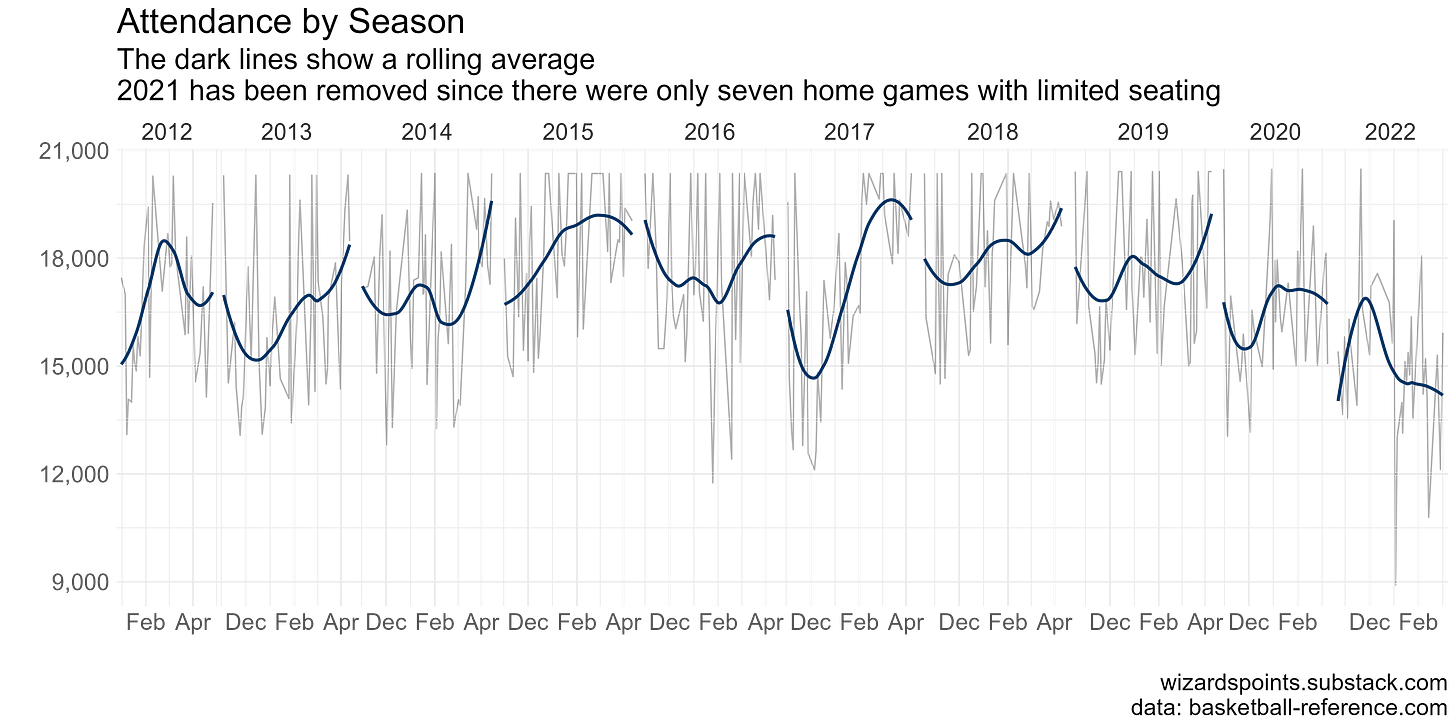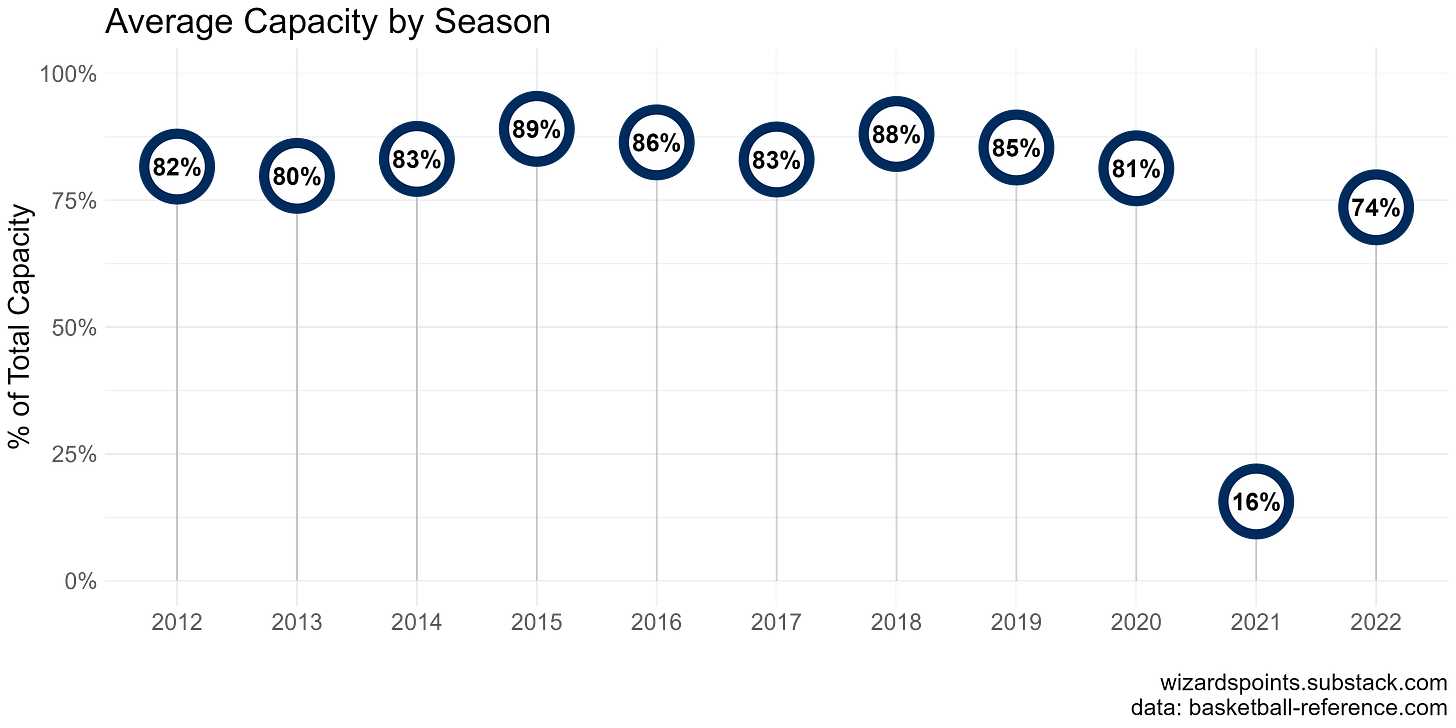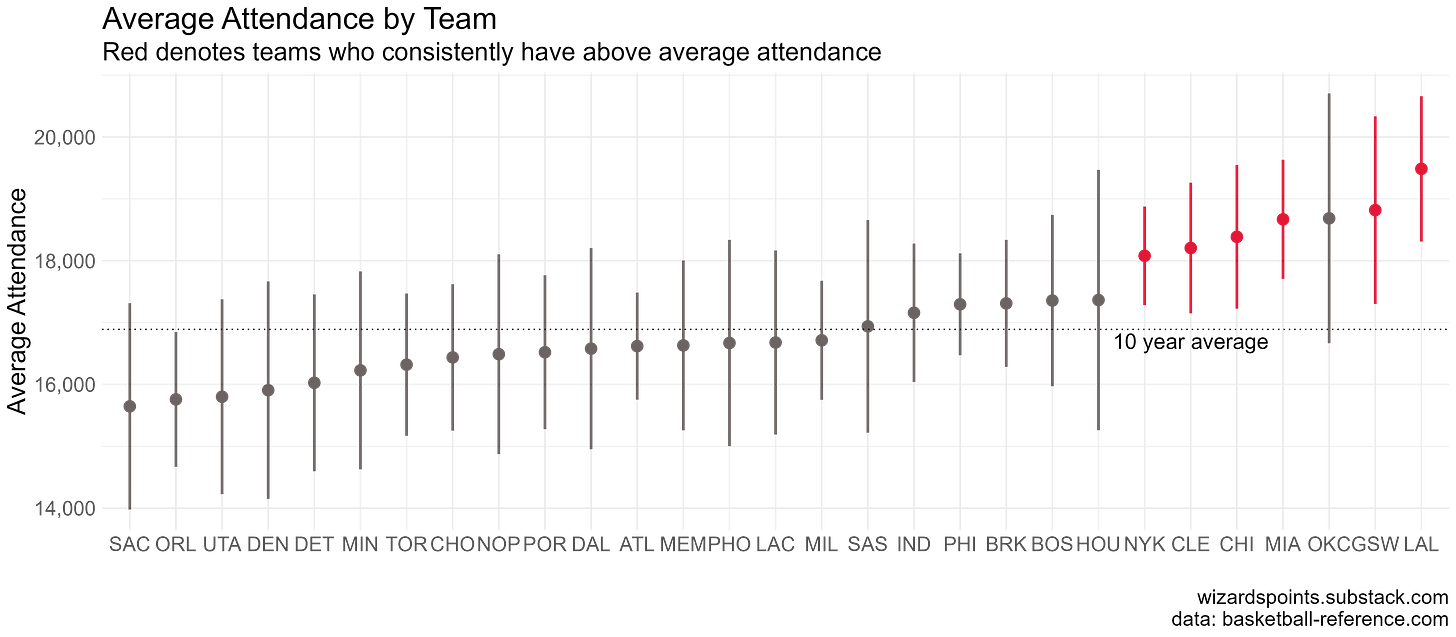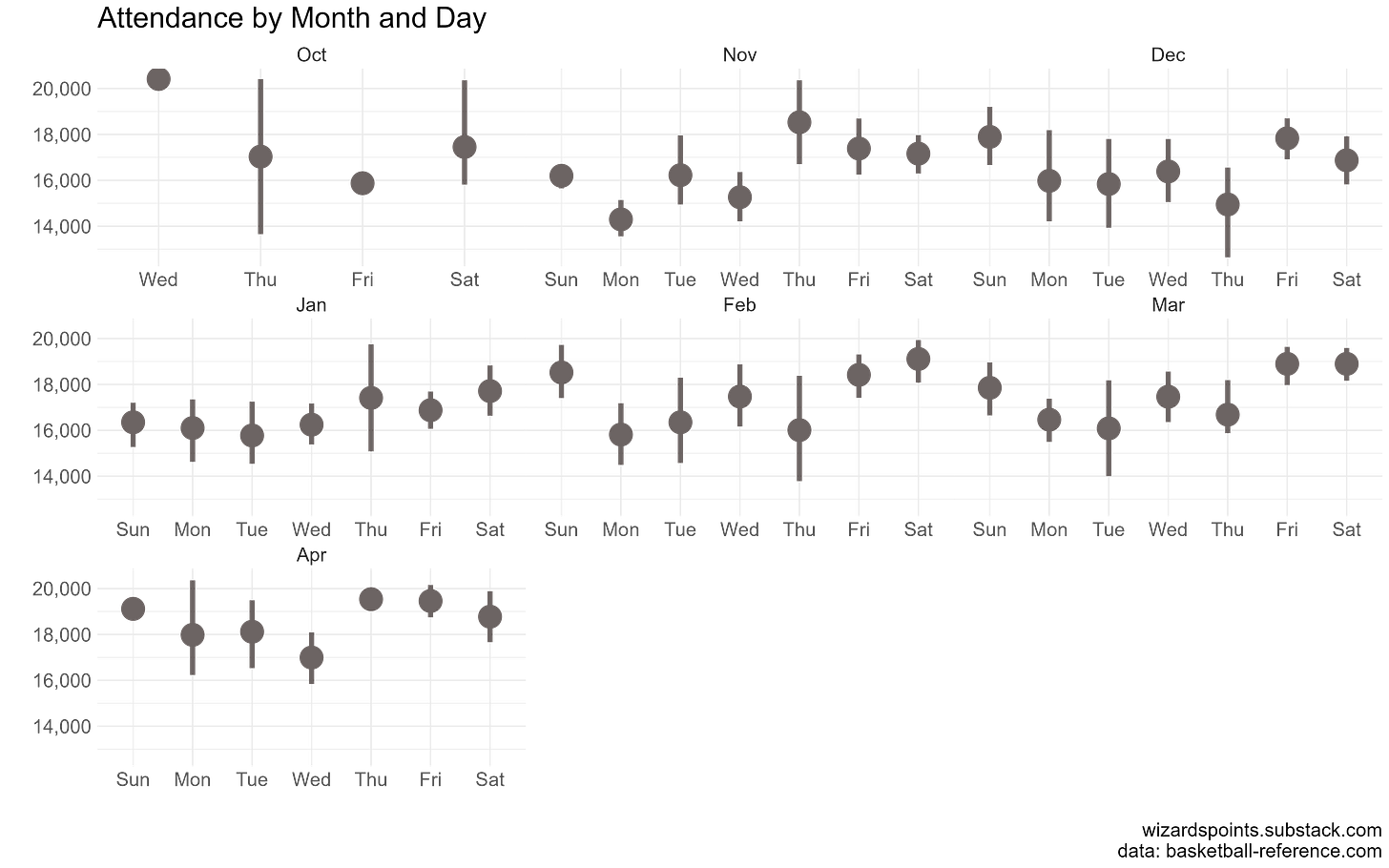This one is for the fans...wherever they are
To be a Wizards fan is to live with a thousand small humiliations. I missed part of the first game of the 2017 playoffs because I was outnumbered by people who wanted to watch a re-run of Star Trek: The Next Generation on the tv at my old neighborhood bar. There are other, more team-related embarrassments of course. I’m talking about Andray Blatche showing up with a spelling error on his jersey. Choosing Soulja Boy over Jay-Z.1 And, perhaps most frustrating, going to a game only to realize you’re sitting in front of a bunch of Celtics or Sixers fans. And not just sitting near them, but severely outnumbered. And then there are the games where it seems like no one shows up at all.
At least that’s how it feels, especially this season. But what do the numbers say? Do people actually go to Wizards games? Is attendance down more than usual? I decided to scrape attendance data for the past decade of Wizards regular season games to see how things this season compare to past seasons.2
Attendance is down
Looking season-by-season, there is a lot of variation over the course of 41 home games. The overall average regular season attendance for this period between the 2011-2021 season and the current season is 16,890 if you include the limited, 10% capacity 2021 season (zero-fan games excluded), or 17,083 if you remove 2021. Capital One Arena holds 20,476,3 meaning the Wizards have a 10-year average of about 83% capacity. The Wizards get a solid B-grade when it comes to attendance over the past 10 years, which seems about right.
The current season is unique in a lot of ways. There is the pandemic, obviously. The Wizards also had a historically great start. And you can see this in attendance trends: attendance increased through the first few (happy) months of the season, but quickly dropped off during the first few (sad) months of 2022. It wasn’t until the 16th game of the season (and eighth home game) against Miami that the Wiz had a sold out game. In the last 10 home games, Capital One Arena has been at 71% capacity on average.
It is also notable that average regular season attendance hit a high point in 2015, and has started to decline since 2018. So, while the pandemic likely explains some of the decline, you can see the end of the John Wall-era in overall attendance numbers. It is tough to know how attendance would look absent Covid-19. We do know Wall had health issues. In the part of the Wizards multiverse with no pandemic, it still seems possible Wall would have been traded and we would see numbers closer to the start of 2020. But the pandemic did happen and the arena sees about 1,500 fewer fans on average now than it did at this point in the season in 2020 (before the bubble) and 2,200 fewer fans, on average, than it did at this point in the season in 2019.
Why?
Isn’t this always the question with the Wizards? As far as attendance goes, I took a look at some of the things that seem to be associated with higher or lower ticket sales. One of the main drivers of ticket sales is the visiting team. Everyone wants to see Steph Curry, KD, and Giannis. I have paid (or, really, overpaid) to watch the Wizards play end of season games against Orlando and Indiana. But most people would rather go to one good game a year when a contender comes to town than see a bunch of mid- or lower-tier teams play in DC.
The horizontal lines in the figure below show the range of average attendance per team. There is a lot of season-to-season variation that I tried to capture in those horizontal lines. I wanted to keep the figure simple, but suffice it to say that seasonal variation tracks where stars go. Some “legacy” teams from big cities, like the Knicks and Bulls, also have consistent attendance. For example, OKC (third from the right) was not a draw for fans in 2012 or 2013, but sold out the arena from 2014 through 2018 (weirdly, there were no home games against the Thunder in 2019 or pre-bubble 2020), and then reverted back to selling 68% of seats this season.
The team and season alone explain about 74% of the variation in the regular season per-game attendance data. This isn’t too surprising. I fit a model to see what variables correlate with per-game attendance while accounting for season and team variation, as well as the fact that month-to-month attendance varies by day (for example, attendance is generally lower Monday through Thursday).4
Most of the basketball related metrics do not seem to be strong predictors of attendance. I looked at average and lagged (i.e., value from the previous game) field goal attempts and percentage, as well as assists, overall points, average point differential, and team plus-minus, but none of these really drive attendance in the data. So, the actual basketball quality seems to have very little association with attendance.
I also thought that maybe the Wizards win-loss streak might affect attendance, but again, it doesn’t seem to correlate with fans in seats. Things like 538’s “quality” metric and weather data also don’t explain much after accounting for variation from the opposing team, day of the week, and month. So, after spending way too long looking at this data I have good news for Kings fans in DC on Tuesday nights: people tend to go to games when the Wizards are playing popular teams, especially if it’s the weekend.
I wasn’t able to bring in ticket price data for the full 10 seasons, and I could see that moving attendance slightly. But people going to Gallery Place-Chinatown to watch the Knicks are going to go watch the Knicks give or take a few dollars.
It’s much easier to answer “what” than “why” when it comes to attendance.5 Covid-19 might be at a simmer in DC, but habits have changed over the past two years. The idea of sitting inside and cheering for the dance cam with 20,000 strangers is going to be an understandably tough sell for some people who would have gone to games in the past. This is especially true right now as the team gets comfortable in its don’t-call-it-tanking-we’re-just-giving-Cassius Winston-more-minutes mode.
There’s also a bigger issue that doesn’t show up in the data. I walk past Downtown Locker Room a few times a week. It’s the type of place that sells sports gear and where sneakerheads can part with their money with the support of helpful staff. I typically see Bulls jackets or Nets hoodies in the DTLR window. The thing I almost never see—maybe have never seen—is Wizards gear. Sure, if you walk in, you can pick up a Wizards cap, but you have to look past the many, many Lakers and Yankees caps first. This is beyond sports obviously. The Yankees cap is its own thing. But still. Years of good, but not quite great, and sometimes pretty bad, teams takes a toll. Especially given healthy competition from the three other major sports leagues; though, really, like the rest of the country, the NFL (and it’s unfortunate franchise in Landover ) is king in the DC-area. Consistent play and the decline of the pandemic will hopefully lead to a point where the Wizards not only have casual fans, but those fans decide it’s worth checking out a random game against Detroit or some other rebuilding team on a weekday in January.
Watching a game live is its own kind of entertainment, one that’s different from just watching basketball. It’s not surprising that the on-court metrics are not strongly correlated to attendance. Watching on tv is good if you want to make sure you can see each shot from the best angle. But sitting among a bunch of strangers—yeah, even the Boston fans—can be a special experience. You get the corny in-game video clips and t-shirt toss. The high-fives with strangers. The near-miss, but occasional make from the random fan half-court shot. And a different view of the game. You really get a feel for how fast Ish Smith is and how intense Rui’s defense can be while at the game.
Attendance is down this season. It is unlikely to tick back up to pre-pandemic levels over the next seven home games. But being a Wizards fan means learning to find a thousand ways to be hopeful. There are a lot of reasons fans might decide to return for the 2022-23 season. The East is going to be a bastion of good play. We have some of the most interesting young players in the league. Porzingis just arrived. And, as far as I know, there will still be a chance for a free chicken sandwich.
You could argue there is still time for this one to play out.
Notably, this is official attendance. Anyone who has ever been to a weekday night game and looked around at all the empty seats as the announcer reports the total fan attendance knows official ticket sales and people in seats are two different things. I’m ignoring this important, but hard to measure, point for this post.
This number is actually the maximum capacity listed in the data. If you look up Capital One Area’s NBA seating, you’ll find the max capacity is 20,356. I’m not entirely sure where the extra 120 people come from, but I assume some of this is standing room only tickets near the home lockers and related general admission-style seating.
I ran a few different models using the log of attendance as my dependent variable. I explored a basic linear model as well as multi-level models with random team, season, and month effects, and day of the week fixed effects using rstanarm. The median R-squared is 0.87 with all covariates and random effects. There is definitely more that can be done on this front, but I mostly wanted to see the results of a simple model to get a sense of the correlates of attendance. Full code is here.





